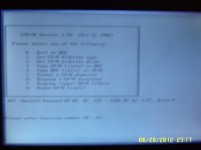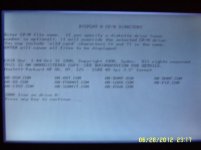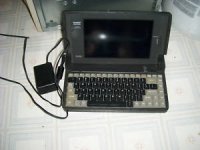smp
Veteran Member
Hello all,
As you may have seen from my various posts elsewhere in the VC Forum, I am having an adventure with my new-to-me HP-86B.
I currently have the following equipment working:
Recently, I have spent my time getting back familiar with CP/M version 2.2, using PIP, ED, ASM and DDT as well as a couple of the old CP/M primers that I have saved over the years.
Now that I have my appetite whetted again, I am looking to embark on getting some additional software running on my machine. I have come up with an interesting problem: How the heck can I get CP/M programs into this machine?
Let me explain: This machine is not your run-of-the-mill CP/M machine. The best metaphor might be an Apple IIe with a Z-80 processor card installed and running CP/M (I never had one of those, but the HP-86B is similarly set up).
The HP-86B has a custom HP processor inside along with 128K of memory for user programs. It normally boots up into its HP proprietary BASIC operating system, and it has the capability for folks to write their own programs, purchase programs for a variety of uses from HP, or utilize programs uploaded by users into HP's user library. In addition to other specialty modules produced by HP, HP also created a module originally named 82900A CP/M System, then later changed to 82900A Auxiliary Processor. Simply stated, this module is a Z-80 with 64K memory and an interface to the HP module bus in the back of the HP-86B. There is a special HP CP/M boot disk that contains 3 files: Autost, CP/M, and CP/MSYS.
Autost is a very small BASIC program that the HP-86B will read from the disk drive if it's available on power-up. It sets the screen size and sets the keyboard to be normally lower case, and then loads the binary called CP/M.
CP/M is the binary that stays resident in the HP-86B, loads the CP/M system into the Z-80 Auxiliary Processor, and performs the interface between the Z-80 and the console and disk interfaces in the HP-86B.
CP/MSYS is a large file on the disk that contains the CP/M file system and the basic files normally expected in a bare bones CP/M system.
I believe this is where my problem lies. If the HP-86B is operating normally as an HP-86B, the CAT command will display the directory of the disk as containing the 3 files I just described. When this disk is used to boot up and run CP/M, the DIR command in CP/M will show the normally expected files: PIP, DUMP, LOAD, DDT, ED, ASM, STAT, SUBMIT, XSUB and FORMAT.
When operating within CP/M, I can create my own programs. I have created my HELLO.ASM program in assembly language using ED, and I have assembled it using ASM. I have used LOAD to create a .COM file from the assembled code. On the disk I now see several additional files in CP/M: HELLO.ASM, HELLO.BAK, HELLO.PRN, HELLO.HEX, and HELLO.COM. Everything seems to be working fine.
Now for the Catch. If I boot up the HP-86B normally and use the HP CAT command again, I still get back the same original 3 files: Autost, CP/M, and CP/MSYS. All my HELLO.* files are buried within the CP/MSYS file.
So, I am looking for a way to get a large source file into CP/M on this system. Time to check out the manuals.
The Introduction to the HP 82900A CP/M System clearly states the operation I detailed above on how the Autost program is detected and then runs the CP/M binary, etc. It also states that when CP/M is running, "The HP 82900A CP/M System appears to standard CP/M software as a 61K CP/M system, version 2.2, with 56K bytes of user memory." Then it says, "Only application software that is HP disc-formatted is compatible with your system." (That sounds pretty ominous to me. )
)
The HP 82900A CP/M System Reference Manual describes the use of PIP, and states that CON: and RDR: are source devices that can be re-mapped to other devices such as TTY:, CRT:, BAT:, PTR:, etc., but then also states that, "All physical input devices use keyboard input." (Things are not getting any better )
)
Similarly, the CP/M Reference Manual states that CON:, PUN:, and LST: are destination devices, and they also can be re-mapped to a variety of devices. Except for mapping CON: to CRT: or BAT:, and mapping LST: to LPT: or CRT:, it also states that, except when using only those mappings, "Output data is lost." (Oh, my! )
)
So, there's my situation. I have the source listing for FIG-Forth, and I was hoping to find a way to get the text file onto a disk and then be able to see it in CP/M on the HP-86B, but I have no idea how I could get the text file into the CP/MSYS file properly for the CP/M file system. As well, it does not appear to me that I have the ability to re-map some input to a serial port (I have the HP-82939A Serial I/O module) where I could create a program to read the text file in under CP/M.
Am I doomed to typing this entire source file in by hand? Am I doomed to typing any source text file that I want in by hand?
Any and all comments, observation, or advice are welcome.
Thanks for listening!
smp
As you may have seen from my various posts elsewhere in the VC Forum, I am having an adventure with my new-to-me HP-86B.
I currently have the following equipment working:
- HP-86B
- HP-9121D dual 3.5 inch floppy drive (single sided, 270K capacity disks)
- Dynex 17" LCD TV / video monitor with underscan capability on the VGA input
- VideoSecu TV Video RCA to PC VGA Converter Adapter Switch Box
- HP-82900A Auxiliary Processor (AKA CP/M System module)
Recently, I have spent my time getting back familiar with CP/M version 2.2, using PIP, ED, ASM and DDT as well as a couple of the old CP/M primers that I have saved over the years.
Now that I have my appetite whetted again, I am looking to embark on getting some additional software running on my machine. I have come up with an interesting problem: How the heck can I get CP/M programs into this machine?
Let me explain: This machine is not your run-of-the-mill CP/M machine. The best metaphor might be an Apple IIe with a Z-80 processor card installed and running CP/M (I never had one of those, but the HP-86B is similarly set up).
The HP-86B has a custom HP processor inside along with 128K of memory for user programs. It normally boots up into its HP proprietary BASIC operating system, and it has the capability for folks to write their own programs, purchase programs for a variety of uses from HP, or utilize programs uploaded by users into HP's user library. In addition to other specialty modules produced by HP, HP also created a module originally named 82900A CP/M System, then later changed to 82900A Auxiliary Processor. Simply stated, this module is a Z-80 with 64K memory and an interface to the HP module bus in the back of the HP-86B. There is a special HP CP/M boot disk that contains 3 files: Autost, CP/M, and CP/MSYS.
Autost is a very small BASIC program that the HP-86B will read from the disk drive if it's available on power-up. It sets the screen size and sets the keyboard to be normally lower case, and then loads the binary called CP/M.
CP/M is the binary that stays resident in the HP-86B, loads the CP/M system into the Z-80 Auxiliary Processor, and performs the interface between the Z-80 and the console and disk interfaces in the HP-86B.
CP/MSYS is a large file on the disk that contains the CP/M file system and the basic files normally expected in a bare bones CP/M system.
I believe this is where my problem lies. If the HP-86B is operating normally as an HP-86B, the CAT command will display the directory of the disk as containing the 3 files I just described. When this disk is used to boot up and run CP/M, the DIR command in CP/M will show the normally expected files: PIP, DUMP, LOAD, DDT, ED, ASM, STAT, SUBMIT, XSUB and FORMAT.
When operating within CP/M, I can create my own programs. I have created my HELLO.ASM program in assembly language using ED, and I have assembled it using ASM. I have used LOAD to create a .COM file from the assembled code. On the disk I now see several additional files in CP/M: HELLO.ASM, HELLO.BAK, HELLO.PRN, HELLO.HEX, and HELLO.COM. Everything seems to be working fine.
Now for the Catch. If I boot up the HP-86B normally and use the HP CAT command again, I still get back the same original 3 files: Autost, CP/M, and CP/MSYS. All my HELLO.* files are buried within the CP/MSYS file.
So, I am looking for a way to get a large source file into CP/M on this system. Time to check out the manuals.
The Introduction to the HP 82900A CP/M System clearly states the operation I detailed above on how the Autost program is detected and then runs the CP/M binary, etc. It also states that when CP/M is running, "The HP 82900A CP/M System appears to standard CP/M software as a 61K CP/M system, version 2.2, with 56K bytes of user memory." Then it says, "Only application software that is HP disc-formatted is compatible with your system." (That sounds pretty ominous to me.
The HP 82900A CP/M System Reference Manual describes the use of PIP, and states that CON: and RDR: are source devices that can be re-mapped to other devices such as TTY:, CRT:, BAT:, PTR:, etc., but then also states that, "All physical input devices use keyboard input." (Things are not getting any better
Similarly, the CP/M Reference Manual states that CON:, PUN:, and LST: are destination devices, and they also can be re-mapped to a variety of devices. Except for mapping CON: to CRT: or BAT:, and mapping LST: to LPT: or CRT:, it also states that, except when using only those mappings, "Output data is lost." (Oh, my!
So, there's my situation. I have the source listing for FIG-Forth, and I was hoping to find a way to get the text file onto a disk and then be able to see it in CP/M on the HP-86B, but I have no idea how I could get the text file into the CP/MSYS file properly for the CP/M file system. As well, it does not appear to me that I have the ability to re-map some input to a serial port (I have the HP-82939A Serial I/O module) where I could create a program to read the text file in under CP/M.
Am I doomed to typing this entire source file in by hand? Am I doomed to typing any source text file that I want in by hand?
Any and all comments, observation, or advice are welcome.
Thanks for listening!
smp



